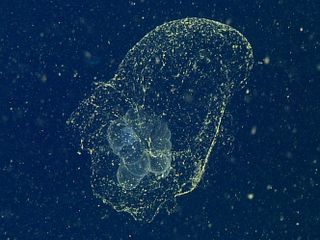
A mysterious sea blob that looks like a psychedelic Slinky has finally been spotted, more than a century after it was first described.
The translucent, sea-dwelling invertebrate, called Bathochordaeus charon, was identified recently off the coast of Monterey, California, by scientists using a remotely operated vehicle (ROV). Though B. charon was first discovered a century ago, no one had managed to confirm its existence in all those years, Rob Sherlock, a scientist at the Monterey Bay Aquarium Research Institute who found the creature, told Live Science in an email. [See Photos of the Translucent Sea Blob]
Mysterious sea creature
B. charon belongs to a group of sea creatures known as larvaceans — normally teensy, millimeter-size creatures whose bodies resemble a tadpole's, with a large "head" (actually a trunk) and a tail, Sherlock said.

Though the sea is teeming with tiny larvaceans, the larger versions, which can have bodies extending up to 3.9 inches (10 centimeters), are much less common. To eat, the sea blob filters food through its shimmering, parachute-like mucus "house" almost 3.3 feet (1 m) in length. By waving its tail, it stirs the water and pulls particles directly into its house. Large particles get trapped and form a fine dusting of marine "snow" on the house, while the smaller particles pass through, concentrating and then funneling into a feeding tube that goes into the mouth, Sherlock said. (The tiny larvaceans also don mucus homes, but they're smaller.)
If a passing squid or fish crashes through the house, or big particles clog the feeding tube, larvaceans simply move on and build another house. Without their houses, they cannot eat, Sherlock said.
First sightings
The first report of B. charon's existence came in 1899, when professor Carl Chun of Leipzig University came across one in the south Atlantic Ocean while leading the Valdivia Expedition, a German mission aimed at exploring the deep sea. Chun believed the creature welled up from the deepest depths of the ocean, so he named the larvacean after Charon, who in Greek mythology ferries the souls of the dead across the river Styx, the researchers reported Aug. 16 in the journal Marine Biodiversity Records.
In the decades that followed, several other naturalists reported spotting giant larvaceans, though only a few were captured alive and described thoroughly. In 1936, for instance, British marine biologist Walter Garstang collected a set of giant larvaceans that differed from Chun's, and they were classified as a new species, Bathochordaeus stygius. [Marine Marvels: Spectacular Photos of Sea Creatures]
Sign up for the Live Science daily newsletter now
Get the world’s most fascinating discoveries delivered straight to your inbox.
Because the two sets of specimens were similar and Chun's originals were lost to history, scientists eventually began to wonder whether Chun's originally described B. charon was actually the same species as B. stygius. One famous larvacean expert even suggested combining the two species names, Sherlock said. Part of the difficulty in capturing these creatures is that they don't fare well in the trawling nets typically used to collect specimens, Sherlock said.
Hiding in plain sight
Sherlock and his colleagues happened upon the new species when the team's ROV, called Doc Ricketts, was exploring the waters of Monterey Bay. As soon as they saw it, the crew carefully collected it in a sealed, thermally insulated container.
"Since the vehicle was recovered some tens of minutes later, the animal was alive, in fantastic shape, and we preserved it right away in order to send it to the Smithsonian," Sherlock said. "We had no idea, until we looked more closely at the specimen, that we had actually found B. charon, the species first described over a hundred years ago."
Genetics and analysis of physical features confirmed the find, Sherlock said. It was official: There really were two distinct species of giant larvacean — B. stygius and B. charon.
"It felt like Chun had finally been vindicated after years of doubt," Sherlock said.
When the team went back over videos from Monterey Bay from the past 25 years, they realized the creature had been spotted many times in the bay. Whether they dwell in places between Monterey Bay and the South Atlantic, however, remains to be seen.
Still, this mythical sea blob is fairly rare; over the course of the past few decades, biologists have seen hundreds of B. stygius, but captured footage of only a dozen B. charon individuals, Sherlock said.
Original article on Live Science.

Tia is the managing editor and was previously a senior writer for Live Science. Her work has appeared in Scientific American, Wired.com and other outlets. She holds a master's degree in bioengineering from the University of Washington, a graduate certificate in science writing from UC Santa Cruz and a bachelor's degree in mechanical engineering from the University of Texas at Austin. Tia was part of a team at the Milwaukee Journal Sentinel that published the Empty Cradles series on preterm births, which won multiple awards, including the 2012 Casey Medal for Meritorious Journalism.